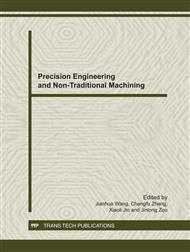[1]
Bonard; Jean-Marc; Kind; Hannes; Stockli; Thomas; et al. Field emission from carbon Nanotubes: the five years. Solid-State Electronics, 45(2001) 893-914.
DOI: 10.1016/s0038-1101(00)00213-6
Google Scholar
[2]
Alexander T.; Hatton K.; Fuhrer M. S.; Paranjape M.; and Barbara P.; A photolithographic process for fabrication of devices with isolated single-walled carbon nanotubes. Nanotechnology, 15(2004) 1475-1478.
DOI: 10.1088/0957-4484/15/11/017
Google Scholar
[3]
Joselevich E.; & Lieber C. M.; Vertical growth of metallic and semiconducting single-wall carbon nanotubes. Nano Letters, 2(2002) 1137-1141.
DOI: 10.1021/nl025642u
Google Scholar
[4]
Wakaya F.; Takaoka J.; Fukuzumi K.; Takai M.; Akasaka Y.; & Gamo K.; Fabrication of a carbon nanotube device using a patterned electrode and a local electric field .Superlattices and Microstructures, 34(2003) 401–405.
DOI: 10.1016/j.spmi.2004.03.036
Google Scholar
[5]
Chung J.; & Lee J., Nanoscale gap fabrication and integration of carbon nanotubes by micromachining .Sensors and Actuators A, 104(2003) 229–235.
DOI: 10.1016/s0924-4247(03)00025-6
Google Scholar
[6]
Huang Y,Duan X F and Wei Q Q,et al.Science, 291(2001)630.
Google Scholar
[7]
Ko H.; Peleshanko S.; & Tsukruk V. V.; Combing and Bending of Carbon Nanotube Arrays with Confined Microfluidic Flow on Patterned Surfaces. The Journal of Physical Chemistry Part B 108(2004), 4385-4393.
DOI: 10.1021/jp031229e
Google Scholar
[8]
Huijun Xin and Adam T. Woolley. Directional Orientation of Carbon Nanotubes on Surfaces Using a Gas Flow Cell.Nano Letters, 4(8)(2004)1481-1484.
DOI: 10.1021/nl049192c
Google Scholar
[9]
Liu, Jie; Casavant, Michael J.; Cox, Michael; Walters, D. A.; Boul, P.; Lu, Wei; Rimberg A. J.; Smith, K. A.; Colbert, Daniel T.; & Smalley, Richard E.; Controlled deposition of individual single-walled carbon nanotubes on chemically functionalized templates. Chemical Physics Letters, 303(1999) 125–129.
DOI: 10.1016/s0009-2614(99)00209-2
Google Scholar
[10]
Avouris Ph.; Hertel T.; Martel R.; Schmidt T.; Shea H. R.; & Walkup R.E.; Carbon nanotubes: nanomechanics, manipulation, and electronic devices. Applied Surface Science 141, 201-209
DOI: 10.1016/s0169-4332(98)00506-6
Google Scholar
[11]
Roschier L.; Penttila J.; Martin M.; Hakonen P.; & Paalanen M.; Single-electron transistor made of multiwalled carbon nanotube using scanning probe manipulation. Applied Physics Letters 75(1999), 728-731.
DOI: 10.1063/1.124495
Google Scholar
[12]
Decher G and Hong J D. Buildup of Ultrathin Multilayer Films by a Self-Assembly Process. Consecutive Adsorption of Anionic and Cationic Bipolar Amphiphiles and Polyelectrolytes on Charged Surfaces. Ber. Bunsen Phys.Chem., 95(11) (1991):1430-1434.
DOI: 10.1002/bbpc.19910951122
Google Scholar
[13]
X.B. Yan, X.J. Chen, B.K. Tay, K.A. Khor. Transparent and flexible glucose biosensor via layer-by-layer assembly of multi-wall carbon nanotubes and glucose oxidase. Electrochemistry Communications, 9(2007)1269–1275.
DOI: 10.1016/j.elecom.2006.12.022
Google Scholar


